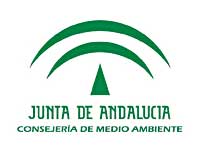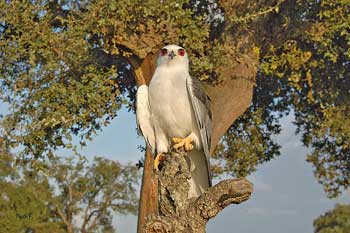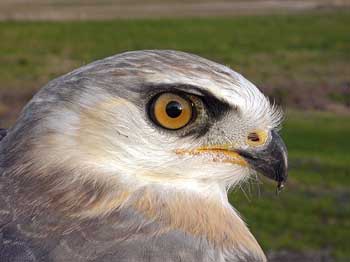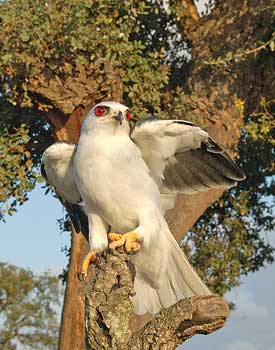| |

ORNITHOLOGY:
a passion that grows every year thanks to the enthusiasm of the promoters from the province of Huelva and the success of the projects currently underway.
Sara Mañas Lezameta
 The black-winged kite (Elanus caeruleus), with its characteristic red ocular pigmentation, is a daytime bird of prey, with significant genetic similarities to the owlet; it is the object of observation by JM Sayago on behalf of the Huelva Council for the Environment. The black-winged kite (Elanus caeruleus), with its characteristic red ocular pigmentation, is a daytime bird of prey, with significant genetic similarities to the owlet; it is the object of observation by JM Sayago on behalf of the Huelva Council for the Environment.
Pale grey coloured on its back, with a black stain on its shoulders, it has a white tummy and it can be admired in the barren countryside cultivated for cereals or pastures with few trees on the Iberian Peninsula. In fact, one of the difficulties encountered in studying this bird of prey is the change of the agricultural use of the land, which obliges it to engage in frequent location changes.
With the first and last light of the day, we can admire this splendid bird of prey as it hunts, hovering over small mammals (mice) amidst the cereal cultivations or meadows. The remainder of the time it stays in one of its usual positions, alone or with its brooding female mate. During autumn and winter evenings on the other hand, you will see more than 50 species on the dry and isolated trees they choose as a night-time refuge, with good visibility over the surrounding area. 
The Quercus species (cork-oak, oak) are ideal for nest building and in the province of Huelva you will also encounter nests on olive trees (Olea Europea).
In the autumn-winter period of 2006-2007, when twelve nests were found to have been built successfully by the respective couples of reproducers, it was proven that the long period of hatching that had been sustained up to that time, between January and the end of August, at least in the province of Huelva, had extended throughout the whole year. The brooding time depends exclusively on the ability to find food. If conditions are favourable, they can reproduce every two months. While the male remains to nourish his little ones, the female abandons the nest to seek a new mate and begin another cycle. Every deposition will be made up of an average of approximately four eggs. This reproductive capacity is causing the population in Huelva to increase, despite adversities, because more than 20 reproducing couples have been localised.
Observation began in 2006 with the collaboration of environmental volunteers from the Maremme de Odiel National Park, further to a proposal presented by JM Sarago, who mentioned information on the reproduction of the black-winged kite in the grassland areas of the Huelva province for the first time in 1995.
 Among the work that has been done to date, the most outstanding achievement is the sampling of the birds. The exemplars are captured to be marked: a metallic ring with the numbering of the Ministry for the Environment is placed on their tarsus and a synthetic canvas mark with alphanumerical symbols is attached to their patagium, this is an innocuous procedure for the bird, which can be identified perfectly from that moment, both when it is stationary and when it is flying. Thanks to the data obtained, the number of exemplars in existence has been verified, along with the ratio of young species / adult species, the sedentary nature or the local movements, loyalty to certain territories, biometric data, reproductive success, changes in ocular pigmentation, changes in feathering etc… Among the work that has been done to date, the most outstanding achievement is the sampling of the birds. The exemplars are captured to be marked: a metallic ring with the numbering of the Ministry for the Environment is placed on their tarsus and a synthetic canvas mark with alphanumerical symbols is attached to their patagium, this is an innocuous procedure for the bird, which can be identified perfectly from that moment, both when it is stationary and when it is flying. Thanks to the data obtained, the number of exemplars in existence has been verified, along with the ratio of young species / adult species, the sedentary nature or the local movements, loyalty to certain territories, biometric data, reproductive success, changes in ocular pigmentation, changes in feathering etc…
Their diet is studied through pellets, using a method that was already applied in other studies of the species (Juanjo Negro). Periodical radio observation of some of the birds marked with micro-emitters defined their habitual positions.
The high percentage of young reproducing species (less than 7 months old) indicates that Huelva constitutes a collection of exemplars originating from nearby provinces such as Cadiz or Seville and also Estremadura and Portugal, but this should also perhaps be a warning sign of the high mortality rate due to illegal hunting and crashes.
 The cataloguing of the black-winged kite as a species of special interest heightens the need to adopt measures for its conservation. The excitement of seeing this small but powerful bird of prey illuminated by the light of the dusk, in the red colours of the sky and the pastures, amidst robust olive trees, oaks or cork oaks, reawakens a profound respect for nature and its complex balance. The cataloguing of the black-winged kite as a species of special interest heightens the need to adopt measures for its conservation. The excitement of seeing this small but powerful bird of prey illuminated by the light of the dusk, in the red colours of the sky and the pastures, amidst robust olive trees, oaks or cork oaks, reawakens a profound respect for nature and its complex balance.
The ever-growing number of ornithology experts has made it possible to complete the projects commenced by JM Sayago: observation and sampling of the eagle-owl, the owl and the white stork in those areas of the Huelva province that are suitable; the sheldrake, waders, terns in migration and the marsh hawk as well as the hibernation fisher hawk in the Maremme de Odiel National Park.
Aware of the privilege of being able to access this natural spectacle, as well as having the good fortune of being able to share it with a great group of volunteers, we would invite you to participate in the projects that take place throughout the year.
|
|